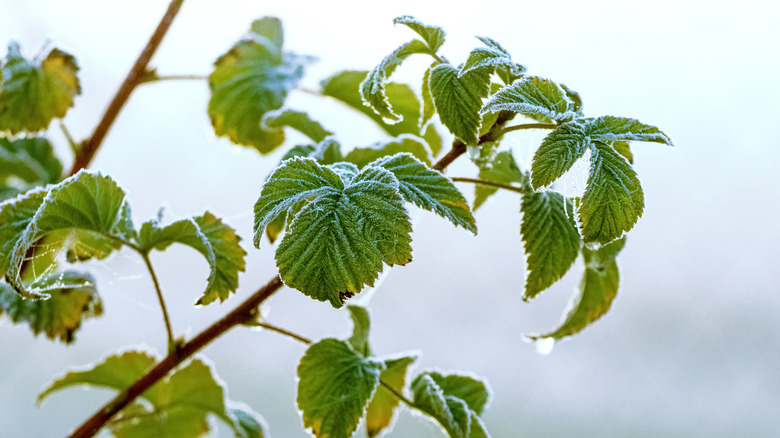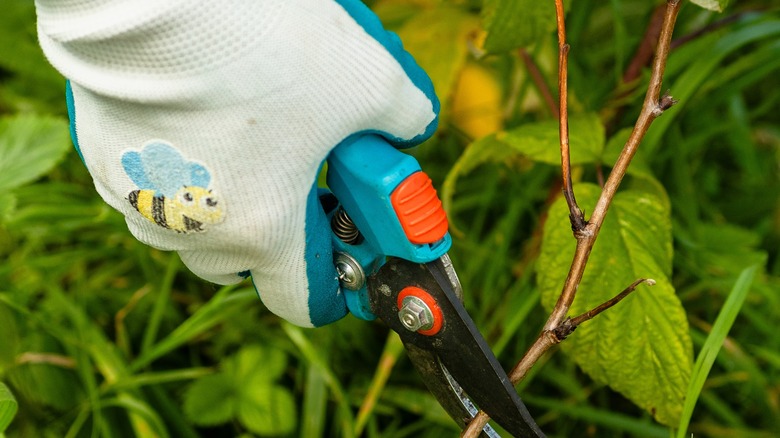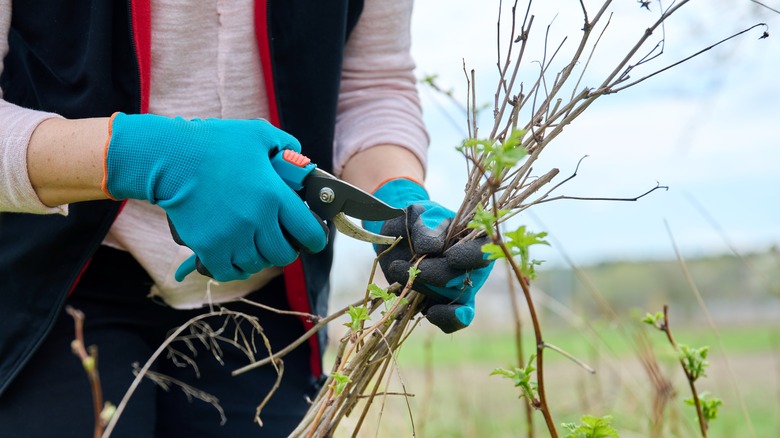How To Winterize Your Raspberry Plant For A Stronger Harvest Next Summer
How much tasty fruit you get from your berry patch directly correlates to how well you care for your plants throughout the year. When it comes to raspberries (Rubus idaeus), proper care is critical throughout the seasons, especially going into winter. While raspberries are hardy in Zones 4 to 8, tending to them in the fall sets the stage for a bigger, juicier harvest next year. Some of the most important fall chores for raspberries, such as cleaning up and mulching, apply to their two primary types of raspberries, primocanes and floricanes. However, some specific differences in care practices can impact how many raspberries you harvest in the future.
It's important to understand the difference between primocanes and floricanes on raspberries before creating a winterization plan. Most raspberry varieties grown by home gardeners are floricane raspberries. They bear fruit in mid-summer on 2-year-old canes, meaning new stalks that grew up from the ground this year will be producing berries next season. The canes that just fruited can be pruned to make room for healthy new growth. Everbearing, or primocane raspberries, fruit twice each year: once in the summer on last year's canes and once in the fall on new stalks that came up in the spring. Whether you choose primocanes or floricanes, there are very few mistakes you can make that will kill a raspberry bush. If you pay them that extra bit of attention in the fall, they'll reward you with red and gold treasures each year.
Pruning floricane and primocane raspberries
Proper fall care for your raspberry plant starts by cleaning up your raspberry patch. This includes pruning second-year canes that bore fruit in the summer, as these will not produce again. Trim dead or diseased branches to improve air circulation and reduce the risk of spreading disease.
Fall-bearing raspberries, (primocanes) usually referred to as everbearing raspberries can be treated a little differently at the end of the growing season. The canes that bear fruit in the fall will also produce fruit next summer. However, you'll also have new stalks in the spring that will bear fruit next fall. This will leave you with two choices for pruning. First, you can treat them like floricanes, cutting out only the 2-year-old canes. In this case, they will bear fruit twice each year, once in the summer and once in the fall. The second option is to cut back all the primocane raspberry stalks. This eliminates the summer harvest, but the benefit would be they'll produce plump, juicy fruit in October. It's best to wait to prune until all of the leaves have dropped and the plant has gone dormant. Raspberry plants are also easier to transplant after they've been pruned.
General care to prepare your raspberries for winter
In addition to pruning, fall cleanup is an important step to ensure healthy plants through the winter for abundant fruit next season. Although they are vigorous growers, raspberries can become infected by wild brambles and other garden plants. Cleaning up fallen leaves and debris is a good way to prevent these types of diseases and other pest infestations. You can either prune or mow around the patch to keep it from spreading, or thin and transplant some plants to a new location to increase the size of your patch. Raspberries also need water in the fall if the soil is dry or your region hasn't received much rain. After watering them, you can add a fresh layer of mulch to your raspberry patch in cold climates. This provides insulation and prevents moisture loss through the winter, helping to protect the plant's shallow root system.
Fall is also a good time to check the trellises for your raspberries or build new ones if yours are old or you expanded the size of your patch. Whether you choose a mound supported by a single pole or a trellis system with wires, giving your plants some support helps keep the fruiting canes off the ground.


